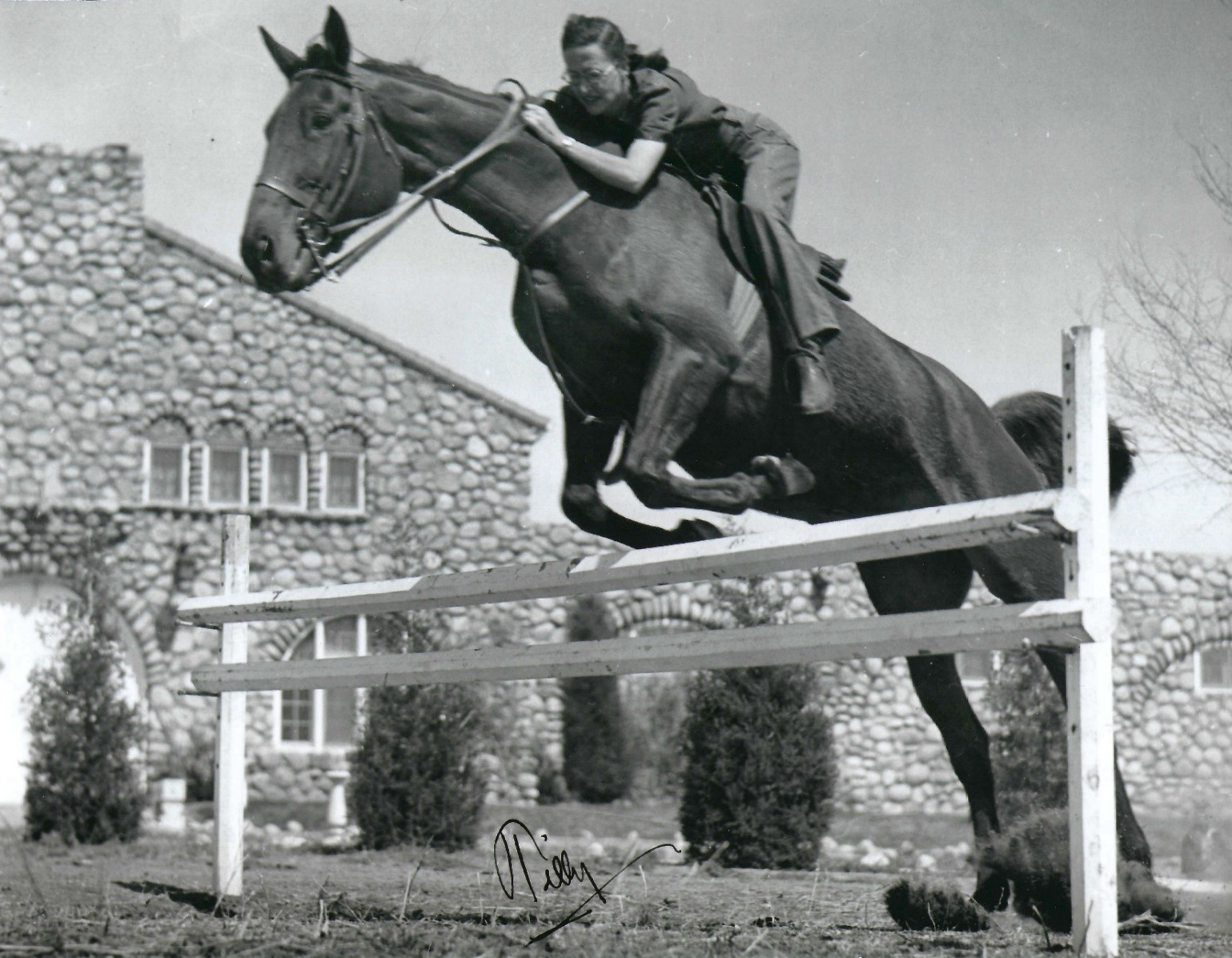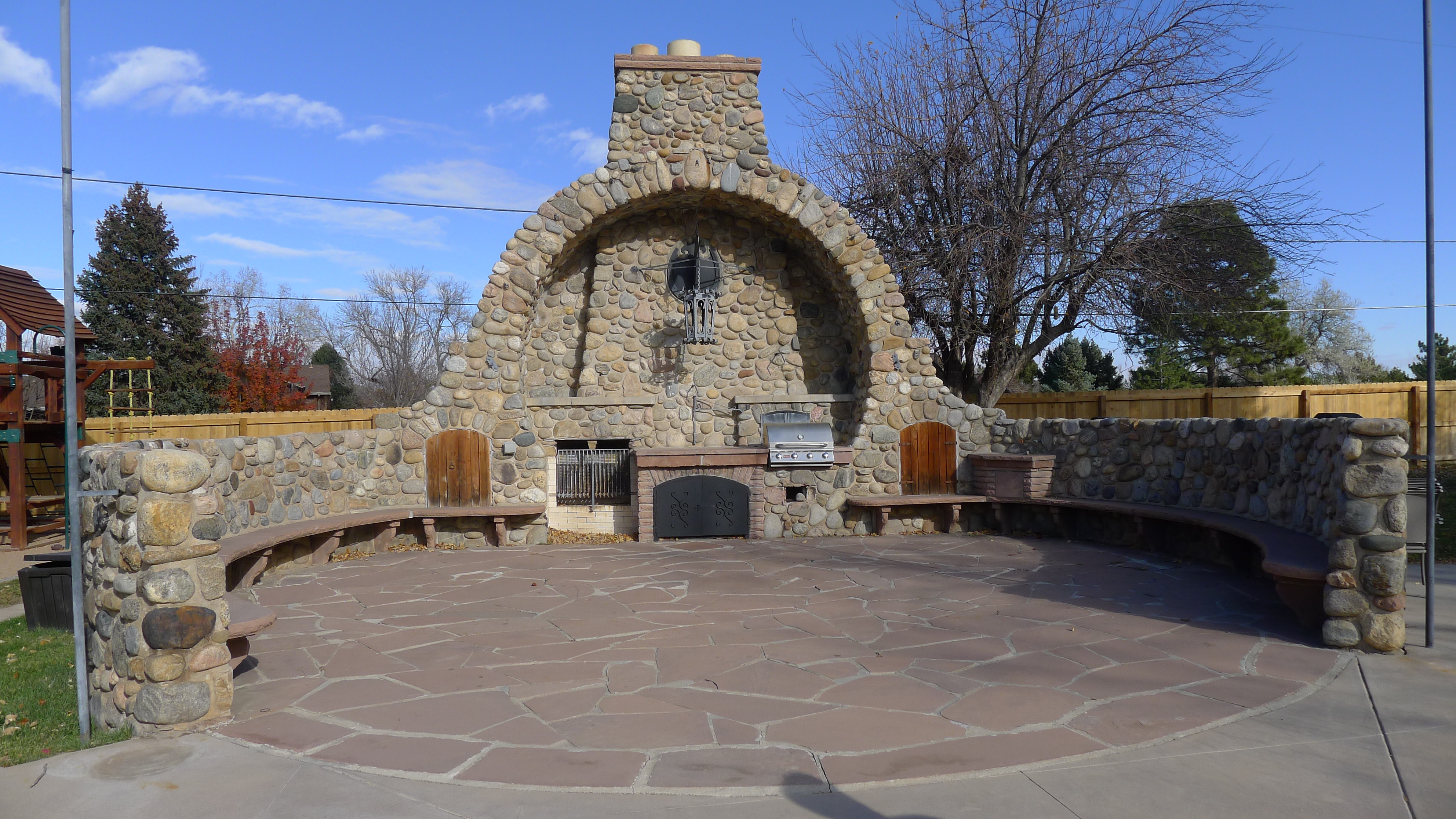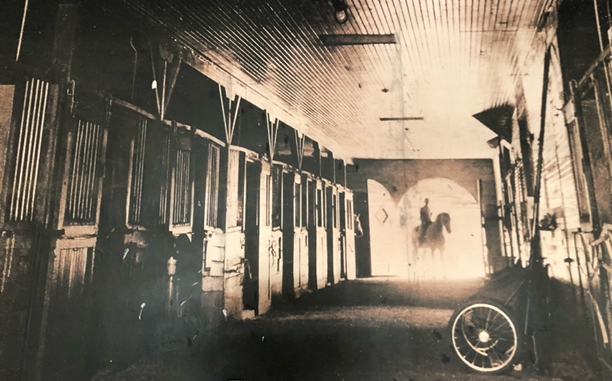
Story
Sidesaddle Sanctuary
Nestled in Cherry Hills Village along the High Line Canal trail, a unique stable connects the past of women’s sports to the present.
Listed in the Colorado State Register of Historic Properties in 2022, the Village Club—formerly the Kistler Stables—stands out immediately for its beautiful but unusual buildings. The river-rock stable and outdoor kitchen incorporate Spanish Revival style elements but with a playful twist. The buildings use horseshoe and collar shapes to evoke their purpose. This oasis was the brainchild of Florence Hughes Kistler, who envisioned a secluded place for her daughters and the young women of Denver to compete in equestrian sports.

An unknown rider begins a side-saddle jump, with the stables visible in the background. Although we don’t know the rider’s name, we can guess that this horse was named “Tilly” based on the handwritten note at the bottom of the photo. About 1940s.
Born Florence Hughes in Illinois in 1879, Florence grew up on her family’s ranch raising chickens and riding horses. In 1903 she married gas executive Frank Kistler, with whom she had four children. The family moved to Denver in 1917, and Frank’s fortunes blossomed. Soon the family owned a Denver home on High Street, a mansion in Douglas County that formerly belonged to oil executive Waite Phillips, and a prized ranch in Estes Park. At the family’s mountain retreat, Florence had a chance to indulge her love of horseback riding. But in January 1929, when Frank filed for divorce from Florence and two weeks later married Leana Antonides, Florence Kistler suddenly found herself raising their three youngest children—all teenage daughters—on her own.
Despite major shakeups to their home life, Kistler and her daughters maintained their love of horses, and gained attention for their outstanding equestrianism. Daughters Florence and Frances made headlines for showing horses many times in the 1930s. Taking things to the next level, Florence Kistler purchased acreage in Cherry Hills in 1935 to build a boarding and showing facility. She hired Denver architect Temple Buell, himself an equestrian who kept horses in the Cherry Hills area. Together, they planned a gracefully appointed club with cobblestone stables, arenas, a large chicken coop, gardens, and a show-stopping horseshoe shaped outdoor kitchen. The facility opened for business in January of 1937 with a grand “Midnight Feast” to mark the occasion.

The hoofprint-shaped outdoor kitchen. The benches form a part of a horseshoe on the print, and the wrought iron chandelier hardware is shaped like a collar. Autumn 2021.
Women have not always been welcomed in competitive sports spaces, and Colorado—a place well-known for its outdoor recreation culture today—was no exception when Florence Kistler built her stables. While Denver’s female equestrians in the 1930s might have found places for pleasure riding, few arenas offered them the chance to show their animals and their skills. The Kistler Stables were one of the few places where women could compete. They have also served as headquarters for several women’s and girls' riding clubs, including the Denver Equestrian Association and the Bit and Spur, Picadero, Hunt, and Chevy Chase Riding Clubs. In fact, Florence Kistler managed the Chevy Chase club’s annual show at the stables in 1937, and her daughter Frances Kistler personally sponsored the Bit and Spur club after 1948. The facility hosted other events including a charity rodeo to benefit the Red Cross during World War II, and put on horse shows judged by the Kistler daughters.
By the 1950s, with Kistler in her seventies and none of her children in a position to take on the facility, she sold the property. While managed by Florence and her daughters, the Kistler Stables were unique as a woman-owned and operated oasis for female competitors. Although the stables catered to women of privilege, they supported women’s clubs and organizations, and helped change the landscape of female equestrian competition in Colorado.

An unidentified woman, likely Florence Kistler, rides a horse past the front door of the stable in 1938.
Women & Girls Outdoors:
For more sites that celebrate and preserve the history of women and girls in the great outdoors, visit one of these beautiful spaces:
Camp Nizhoni, Gilpin County: Founded as an answer to segregation within the YWCA, Camp Nizhoni was the first camp for African American girls in Colorado. Camp Nizhoni provided a safe place for Black youth to enjoy and learn about the outdoors.
Beatrice Willard Alpine Tundra Plots, Rocky Mountain National Park: Dr. Beatrice Willard was an internationally recognized ecologist who made significant contributions to environmental policy. She installed two alpine tundra research plots in Rocky Mountain National Park in 1959, where she made important discoveries in the fragility of tundra ecosystems.
Camp Dunraven, Estes Park: Camp Dunraven was the first permanent summer camp for the Campfire Girls in the Estes Park valley. The camp offered activities such as hiking, sports, horseback riding, handcrafts, and performing arts.
